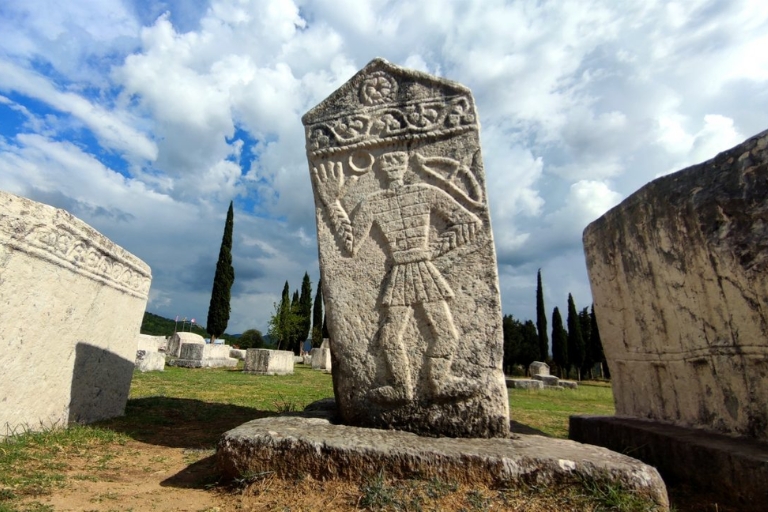When you travel through Herzegovina, which is an area in the southern part of Bosnia and Herzegovina, you will come upon a hidden gem that perfectly depicts the rich tapestry of the region’s history. The Radimlja necropolis is a field with 135 tightly packed rows of medieval tombstones, and it is located just 3km west of the town of Stolac. These white stones have elaborate geometric designs, moons, stars, and figures carved into them, and looking at them will make you think of the people buried beneath. Not just any cemetery, but a significant repository of your nation’s history.
What Are Stećci?
Stećci (pronounced “stech-tsee”) are monolithic tombstones and are among Bosnia and Herzegovina’s most distinctive and enigmatic landmarks. Scattered across the nation’s countryside, approximately 60,000 of these medieval stone monuments are found, with a few also located in neighboring Croatia, Serbia, and Montenegro. Typically grouped in necropolises, these stones emerge from the Bosnian hills and meadows, their vivid designs continuing to intrigue historians and travelers alike. For you, they might serve as a symbol of Bosnia’s multi-ethnic pride and identity.
The Historical Significance of Stećci
Made between the twelfth and the sixteen centuries, stečci are more than just ordinary gravestones. They are festively decorated with religious crosses and rosettes among other things. Certain stones have weaponry, which would suggest the deceased’s socioeconomic level and line of work. Scenes showing funerary dances, chivalric duels, and stag hunts offer amazing insights into medieval Bosnian life. This rich iconography and the inscriptions found on some stećci reveal much about the period’s literacy levels and social customs.
One notable inscription reads, “I once was as you are and you shall be as I am,” from the Viganj Milošević epitaph. Such messages offer a glimpse into the philosophical and reflective aspects of the time.
Derived from the verb “stajati,” meaning “to stand,” the term stečci emphasizes their part in marking graves and recognizing the dead. Their exceptional universal value has won them a position on the UNESCO World Heritage List based on cultural and historical relevance.
A Blend of Cultural Influences
The director of the History Museum of Bosnia and Herzegovina, Elma Hašimbegović, notes that stećci epitomize the intertwining of various cultural influences – Eastern and Western, Mediterranean, Byzantine, and Central European, including both Catholic and Orthodox elements. The presence of Latin and Cyrillic scripts further underscores this blend of influences.
With Orthodox, Catholic, and Bosnian churches coexisting, Medieval Bosnia was a mingling pot of cultures and religions. Stečci thus shows a varied religious past with hints of its use by several groups. While some academics say the Bogomils, a dualistic group, built these tombstones, others connect them to the Vlachs, a nomadic Balkan community.
In Bosnia and Herzegovina, different ethnic groups have been fighting over stećci since the study of them began in the late 1800s. They want to claim them as part of their history. Hašimbegović says that this kind of division is common in societies that have been separated in the past, but he still wants to protect stećci, no matter what the political claims are.

Preservation and Modern Relevance
Radimlja is renowned for its well-preserved stećci, including the iconic image of a male figure with a raised hand, clutching a bow and arrow. Anthropologists suggest this gesture might be a form of prayer to the Sun or Moon. This symbol is deeply embedded in the cultural consciousness, partly due to the Bosnian poet Mehmedalija Mak Dizdar, whose 1966 work “Stone Sleeper” drew inspiration from stećci. His poetry reawakened Bosnians to the significance of these stones, symbolizing cultural openness and historical pride.
Modern Bosnian artists are using stećci to learn more about and show their history. Sculptor Adis Elias Fejzić, for example, has made statues that look like stećaks and have been put up all over the world, including in Australia and Denmark. Fejzić’s work connects the past and the present by showcasing Bosnia’s artistic practices around the world.
Stećci is also inspiring artists like Aleksandra Nina Knežević and Denis Drljević, who works with copper. Both Knežević’s drawings and Drljević’s copper art draw attention to the love, life, and happiness themes on the stones. Fashion and culture have also taken on stećci, with new items like T-shirts, jewelry, and bags honoring these old symbols.
Challenges in Preservation
Many stećci necropolises are ignored, even though they are culturally important. Radimlja, for instance, is in danger because of new factories being built close by. There are many reports of damage and deterioration, which makes people angry and starts debates about who is responsible for protecting these places.
Gorčin Dizdar, a historian and the grandson of the poet Mehmedalija Mak Dizdar has helped protect Bosnian culture by spreading it through the Mak Dizdar Foundation. The Foundation’s most recent project aims to map and scan stećci to make more people aware of them and make sure they will be around for future generations.
Conclusion
The Stećci are significant representations of the cultural heritage of Bosnia and Herzegovina, serving as more than just old grave markers. By delving into these enigmatic stones, you forge a link to a bygone era that influenced the here and now. Contemporary artists and cultural activists are still inspired by stećci, which provides a unique glimpse into medieval life through their elaborate designs and historical importance. You help keep a fundamental connection to your ancestry alive by valuing and backing the preservation of stećci.


